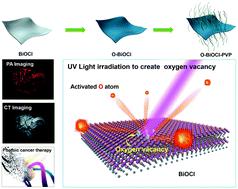当前位置:
X-MOL 学术
›
Nanoscale Horiz.
›
论文详情
Our official English website, www.x-mol.net, welcomes your
feedback! (Note: you will need to create a separate account there.)
Defect engineering of 2D BiOCl nanosheets for photonic tumor ablation.
Nanoscale Horizons ( IF 8.0 ) Pub Date : 2020-02-26 , DOI: 10.1039/c9nh00707e Chen Dai 1 , Ruizhi Hu , Chunmei Wang , Zhuang Liu , Shengjian Zhang , Luodan Yu , Yu Chen , Bo Zhang
Nanoscale Horizons ( IF 8.0 ) Pub Date : 2020-02-26 , DOI: 10.1039/c9nh00707e Chen Dai 1 , Ruizhi Hu , Chunmei Wang , Zhuang Liu , Shengjian Zhang , Luodan Yu , Yu Chen , Bo Zhang
Affiliation

|
Photothermal therapy (PTT) is an emerging technology as a noninvasive therapeutic modality for inducing photonic cancer hyperthermia. However, current photothermal conversion agents suffer from low therapeutic efficiency and single functionality. Engineering crystal defects on the surface or substrate of semiconductors can substantially enhance their optical absorption capability as well as improve their photothermal effects in theranostic nanomedicines. In this study, a specific defect engineering strategy was developed to endow two-dimensional (2D) BiOCl nanosheets with intriguing photothermal conversion performance by creating oxygen vacancies on the surface (O-BiOCl). Importantly, the photothermal performance and photoacoustic imaging capability of the 2D O-BiOCl nanosheets could be precisely controlled by modulating the amounts of oxygen vacancies. The strong Bi-based X-ray attenuation coefficient endowed these nanosheets with the contrast-enhanced computed tomography imaging capability. The high near-infrared-triggered photonic hyperthermia for tumor ablation was systematically demonstrated both in vitro at the cellular level and in vivo for tumor breast cancer mice xenograft models. Based on the demonstrated high biocompatibility of these 2D O-BiOCl nanosheets, this work not only formulates an intriguing 2D photothermal nanoagent for tumor ablation, but also provides an efficient strategy to control the photothermal performance of nanoagents by defect engineering.
中文翻译:

用于光子肿瘤消融的2D BiOCl纳米片的缺陷工程。
光热疗法(PTT)是一种新兴技术,可作为诱导光子癌高热的无创治疗手段。但是,当前的光热转化剂具有治疗效率低和功能单一的缺点。半导体表面或衬底上的工程晶体缺陷可以显着增强其光吸收能力,并改善其在治疗型纳米药物中的光热效应。在这项研究中,开发了一种特定的缺陷工程策略,通过在表面(O-BiOCl)上产生氧空位,赋予二维(2D)BiOCl纳米片以吸引人的光热转换性能。重要的,二维O-BiOCl纳米片的光热性能和光声成像能力可以通过调节氧空位的数量来精确控制。强大的基于Bi的X射线衰减系数使这些纳米片具有对比增强的计算机断层摄影成像功能。对于肿瘤切除小鼠模型,在细胞水平上和体内水平上都系统地证明了用于肿瘤消融的高近红外触发光子热疗。基于这些二维O-BiOCl纳米片的高度生物相容性,这项工作不仅为肿瘤消融制定了一种引人入胜的二维光热纳米剂,而且还提供了一种通过缺陷工程控制纳米剂的光热性能的有效策略。强大的基于Bi的X射线衰减系数使这些纳米片具有增强对比度的计算机断层摄影成像能力。对于肿瘤切除小鼠模型,在细胞水平上和体内水平上都系统地证明了用于肿瘤消融的高近红外触发光子热疗。基于这些二维O-BiOCl纳米片的高度生物相容性,这项工作不仅为肿瘤消融制定了一种引人入胜的二维光热纳米剂,而且还提供了一种通过缺陷工程控制纳米剂的光热性能的有效策略。强大的基于Bi的X射线衰减系数使这些纳米片具有对比增强的计算机断层摄影成像功能。对于肿瘤切除小鼠模型,在细胞水平上和体内水平上都系统地证明了用于肿瘤消融的高近红外触发光子热疗。基于这些二维O-BiOCl纳米片的高度生物相容性,这项工作不仅为肿瘤消融制定了一种引人入胜的二维光热纳米剂,而且还提供了一种通过缺陷工程控制纳米剂的光热性能的有效策略。对于肿瘤切除小鼠模型,在细胞水平上和体内水平上都系统地证明了用于肿瘤消融的高近红外触发光子热疗。基于这些2D O-BiOCl纳米片的高生物相容性,这项工作不仅为肿瘤消融制定了一种引人入胜的2D光热纳米剂,而且还提供了一种通过缺陷工程控制纳米剂的光热性能的有效策略。对于肿瘤切除小鼠模型,在细胞水平上和体内水平上都系统地证明了用于肿瘤消融的高近红外触发光子热疗。基于这些二维O-BiOCl纳米片的高度生物相容性,这项工作不仅为肿瘤消融制定了一种引人入胜的二维光热纳米剂,而且还提供了一种通过缺陷工程控制纳米剂的光热性能的有效策略。
更新日期:2020-02-05
中文翻译:

用于光子肿瘤消融的2D BiOCl纳米片的缺陷工程。
光热疗法(PTT)是一种新兴技术,可作为诱导光子癌高热的无创治疗手段。但是,当前的光热转化剂具有治疗效率低和功能单一的缺点。半导体表面或衬底上的工程晶体缺陷可以显着增强其光吸收能力,并改善其在治疗型纳米药物中的光热效应。在这项研究中,开发了一种特定的缺陷工程策略,通过在表面(O-BiOCl)上产生氧空位,赋予二维(2D)BiOCl纳米片以吸引人的光热转换性能。重要的,二维O-BiOCl纳米片的光热性能和光声成像能力可以通过调节氧空位的数量来精确控制。强大的基于Bi的X射线衰减系数使这些纳米片具有对比增强的计算机断层摄影成像功能。对于肿瘤切除小鼠模型,在细胞水平上和体内水平上都系统地证明了用于肿瘤消融的高近红外触发光子热疗。基于这些二维O-BiOCl纳米片的高度生物相容性,这项工作不仅为肿瘤消融制定了一种引人入胜的二维光热纳米剂,而且还提供了一种通过缺陷工程控制纳米剂的光热性能的有效策略。强大的基于Bi的X射线衰减系数使这些纳米片具有增强对比度的计算机断层摄影成像能力。对于肿瘤切除小鼠模型,在细胞水平上和体内水平上都系统地证明了用于肿瘤消融的高近红外触发光子热疗。基于这些二维O-BiOCl纳米片的高度生物相容性,这项工作不仅为肿瘤消融制定了一种引人入胜的二维光热纳米剂,而且还提供了一种通过缺陷工程控制纳米剂的光热性能的有效策略。强大的基于Bi的X射线衰减系数使这些纳米片具有对比增强的计算机断层摄影成像功能。对于肿瘤切除小鼠模型,在细胞水平上和体内水平上都系统地证明了用于肿瘤消融的高近红外触发光子热疗。基于这些二维O-BiOCl纳米片的高度生物相容性,这项工作不仅为肿瘤消融制定了一种引人入胜的二维光热纳米剂,而且还提供了一种通过缺陷工程控制纳米剂的光热性能的有效策略。对于肿瘤切除小鼠模型,在细胞水平上和体内水平上都系统地证明了用于肿瘤消融的高近红外触发光子热疗。基于这些2D O-BiOCl纳米片的高生物相容性,这项工作不仅为肿瘤消融制定了一种引人入胜的2D光热纳米剂,而且还提供了一种通过缺陷工程控制纳米剂的光热性能的有效策略。对于肿瘤切除小鼠模型,在细胞水平上和体内水平上都系统地证明了用于肿瘤消融的高近红外触发光子热疗。基于这些二维O-BiOCl纳米片的高度生物相容性,这项工作不仅为肿瘤消融制定了一种引人入胜的二维光热纳米剂,而且还提供了一种通过缺陷工程控制纳米剂的光热性能的有效策略。











































 京公网安备 11010802027423号
京公网安备 11010802027423号